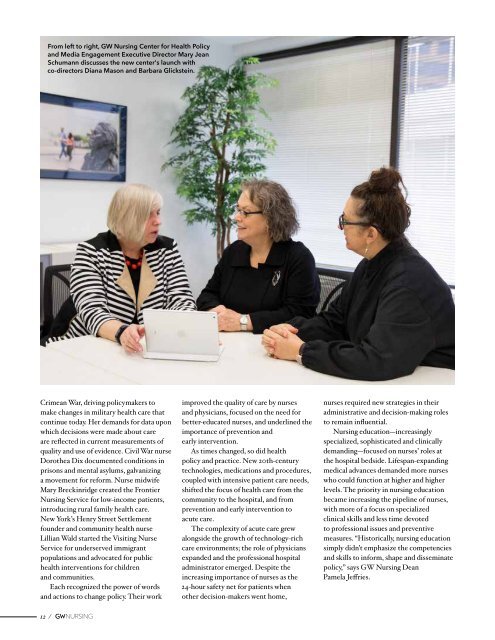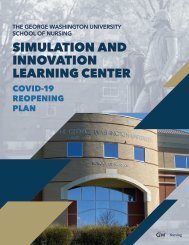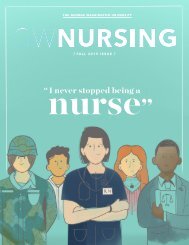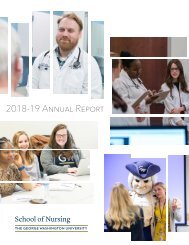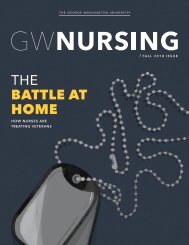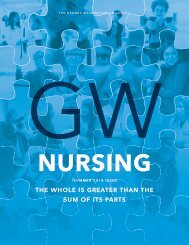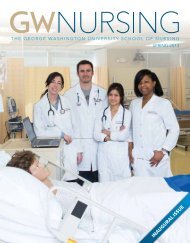GW Nursing Magazine Spring 2017
GW Nursing is a publication of the George Washington University School of Nursing. The magazine tells the story of GW nurses and their endeavors in the areas of education, research, policy and practice.
GW Nursing is a publication of the George Washington University School of Nursing. The magazine tells the story of GW nurses and their endeavors in the areas of education, research, policy and practice.
You also want an ePaper? Increase the reach of your titles
YUMPU automatically turns print PDFs into web optimized ePapers that Google loves.
From left to right, <strong>GW</strong> <strong>Nursing</strong> Center for Health Policy<br />
and Media Engagement Executive Director Mary Jean<br />
Schumann discusses the new center's launch with<br />
co-directors Diana Mason and Barbara Glickstein.<br />
Crimean War, driving policymakers to<br />
make changes in military health care that<br />
continue today. Her demands for data upon<br />
which decisions were made about care<br />
are reflected in current measurements of<br />
quality and use of evidence. Civil War nurse<br />
Dorothea Dix documented conditions in<br />
prisons and mental asylums, galvanizing<br />
a movement for reform. Nurse midwife<br />
Mary Breckinridge created the Frontier<br />
<strong>Nursing</strong> Service for low-income patients,<br />
introducing rural family health care.<br />
New York’s Henry Street Settlement<br />
founder and community health nurse<br />
Lillian Wald started the Visiting Nurse<br />
Service for underserved immigrant<br />
populations and advocated for public<br />
health interventions for children<br />
and communities.<br />
Each recognized the power of words<br />
and actions to change policy. Their work<br />
improved the quality of care by nurses<br />
and physicians, focused on the need for<br />
better-educated nurses, and underlined the<br />
importance of prevention and<br />
early intervention.<br />
As times changed, so did health<br />
policy and practice. New 20th-century<br />
technologies, medications and procedures,<br />
coupled with intensive patient care needs,<br />
shifted the focus of health care from the<br />
community to the hospital, and from<br />
prevention and early intervention to<br />
acute care.<br />
The complexity of acute care grew<br />
alongside the growth of technology-rich<br />
care environments; the role of physicians<br />
expanded and the professional hospital<br />
administrator emerged. Despite the<br />
increasing importance of nurses as the<br />
24-hour safety net for patients when<br />
other decision-makers went home,<br />
nurses required new strategies in their<br />
administrative and decision-making roles<br />
to remain influential.<br />
<strong>Nursing</strong> education—increasingly<br />
specialized, sophisticated and clinically<br />
demanding—focused on nurses’ roles at<br />
the hospital bedside. Lifespan-expanding<br />
medical advances demanded more nurses<br />
who could function at higher and higher<br />
levels. The priority in nursing education<br />
became increasing the pipeline of nurses,<br />
with more of a focus on specialized<br />
clinical skills and less time devoted<br />
to professional issues and preventive<br />
measures. “Historically, nursing education<br />
simply didn’t emphasize the competencies<br />
and skills to inform, shape and disseminate<br />
policy,” says <strong>GW</strong> <strong>Nursing</strong> Dean<br />
Pamela Jeffries.<br />
12 /


